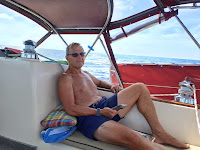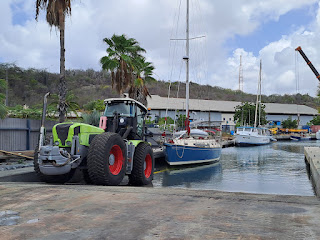But first…….
While we were in Le Marin, Martinique attending to a few boat issues before moving from the mooring ball to the anchorage in St Anne, we decided to take a bus trip to Les Trois–Ilets. This
was where the Empress Josephine, Napoleon Bonaparte’s first wife was born. The bus system in Martinique is reliable, comfortable and cheap, making it easy to get around. While in St Anne, we caught the bus several times into Le Marin for grocery shopping and to sort out the repair work on our boom. Les Trois–Ilets (Three islands) is a picturesque town with the L’Eglise Notre Dame de la Bonne Delivrance (Our Lady of Good Deliverance) being the main focal point of the town. This is apparently where Josephine’s parents were married, 1761, and she was baptised in 1763. We enjoyed walking around the centre of town and down to the small harbour where a few yachts were anchored. It was quite pretty with lots of flowering bushes and shrubs along the roadside and walkways. The bus trip there and back was also quite pleasant as we enjoy seeing different parts of the countryside and island.
was where the Empress Josephine, Napoleon Bonaparte’s first wife was born. The bus system in Martinique is reliable, comfortable and cheap, making it easy to get around. While in St Anne, we caught the bus several times into Le Marin for grocery shopping and to sort out the repair work on our boom. Les Trois–Ilets (Three islands) is a picturesque town with the L’Eglise Notre Dame de la Bonne Delivrance (Our Lady of Good Deliverance) being the main focal point of the town. This is apparently where Josephine’s parents were married, 1761, and she was baptised in 1763. We enjoyed walking around the centre of town and down to the small harbour where a few yachts were anchored. It was quite pretty with lots of flowering bushes and shrubs along the roadside and walkways. The bus trip there and back was also quite pleasant as we enjoy seeing different parts of the countryside and island.
As planned, we moved back to the St Anne anchorage on the Tuesday after the Easter weekend and started making the final preparations for our longest sail of the year to Curaçao. Our plan was to leave for Curaçao on Friday 25 April, after lunch time.
Well like many times in life, things don’t go according to plan. Mel had noticed that the calibration of the GPS to the chart plotter and the autopilot wasn’t correct. To re-calibrate it, one needs very calm and flat conditions, so as we were leaving the entrance to Le Marin and about to enter the anchorage at St Anne, Mel started the calibration. We thought after we had completed it that it was a rather short exercise compared to previous times. It was only as we were setting sail towards Curaçao
on the Friday afternoon, that we realised things were not right. We tried to recalibrate the autopilot about 4 -5NMiles from the anchorage but realised it was not coming right. After a few minutes of deciding on what we should do, we put the engine on and motored back to St Anne’s anchorage. We wanted to leave on the Friday as we were keen to arrive in Curaçao on the Tuesday, 29th as opposed to the Wednesday, 30th as we knew Thursday 1 May and Friday 2 May, were public holidays in Curacao. Despite us checking on the internet, we were not 100% certain what official agencies would be open for checking into Curaçao over the two days of public holidays. We knew the marina would be closed but we were unsure about Immigrations and Customs. In many countries, Customs and Immigrations are open 24/7. Some places are known to charge over time fees, but we also knew there would be no charges in Curaçao. Anyway, before we put the anchor down, we spent quite a while re-calibrating the electronics. This time, everything was much better than before. Thank goodness. So, after a restful night’s sleep, at 6.00am on Saturday 26th April, we started the 500NMiles (plus) sail to Curaçao.
 |
| Mel relaxing during our sail. |
on the Friday afternoon, that we realised things were not right. We tried to recalibrate the autopilot about 4 -5NMiles from the anchorage but realised it was not coming right. After a few minutes of deciding on what we should do, we put the engine on and motored back to St Anne’s anchorage. We wanted to leave on the Friday as we were keen to arrive in Curaçao on the Tuesday, 29th as opposed to the Wednesday, 30th as we knew Thursday 1 May and Friday 2 May, were public holidays in Curacao. Despite us checking on the internet, we were not 100% certain what official agencies would be open for checking into Curaçao over the two days of public holidays. We knew the marina would be closed but we were unsure about Immigrations and Customs. In many countries, Customs and Immigrations are open 24/7. Some places are known to charge over time fees, but we also knew there would be no charges in Curaçao. Anyway, before we put the anchor down, we spent quite a while re-calibrating the electronics. This time, everything was much better than before. Thank goodness. So, after a restful night’s sleep, at 6.00am on Saturday 26th April, we started the 500NMiles (plus) sail to Curaçao.
We spent four nights at sea, only seeing 4 huge container ships the whole time we were out there. The closest ship was 2 NMiles away from us. The wind speed wasn’t as predicted but was much lighter. The swell was comfortable despite us going downwind. We flew the spinnaker. Mel was really excited about that. We’ve had the spinnaker since we bought Passages, and it would appear that it had NEVER been used before. Mel had spent quite a bit of time making sure all the lines and blocks for the spinnaker, were in place on the boat, so when the opportunity presented itself, Mel was keen. I wasn’t, as I am never comfortable when Mel needs to go forward on deck, and we are in the middle of nowhere. It is a common requirement to go on deck when sailing downwind, for example to put the whisker pole up to stabilise the genoa, or to hoist or lower the spinnaker if the opportunity presents itself. During the sail, we also had to contend with currents. One worked slightly against us while another was with us and made us speed along. Like everything, you win some and loose some – ying and yang.
We eventually arrived in Willemstad, Curaçao on Wednesday 30th May at 11.00am ish and arrived at the marina just after 12.00. We had to radio the port control to have the small, floating foot bridge opened for us to enter the harbour area. That was a rock star moment for us, as there are many restaurants along the waterfront. As I was directing Mel around the opening of the bridge, lots of people were watching the whole procedure. I waved…. and Wow, did I get a response. My short moment of fame!
At the dockside waiting for us, was Dave and Monica from sv. Evy. They had only just put their boat, Evy, into the boat yard for storage and were waiting for us to arrive. They had been watching our progress on NoForeignland. It was lovely to be met by familiar faces and to have them help with the docking of Passages after our long sail.
So…... for the next 6 days, we have washed and cleaned almost every part and surface of Passages. She was hauled out of the water on Tuesday 6 May and is now in the boatyard where she will be for the next few months. BTW…... we stopped Starlink at the end of April – the Wi-Fi at the marina and here at the hotel is not great but is manageable. We are spending the next 3 days enjoying the sights of Curaçao. The heat is quite a challenge so thank goodness there is a pool here. In the marina and boat yard, it was quite exhausting! Even the cold water in the showers was not cold so you felt you couldn’t cool off. The aircon on the boat struggled to work as the seawater temperature was 30 degrees and the cooling water pump relied on the seawater to cool itself as well as the aircon.
Anyway….
Here is some information about Curaçao: It is part of what is commonly known as the ABC islands – three of the western most islands of the Leeward Antilles in the Caribbean Sea, Aruba, Bonaire and Curaçao. These islands are along the north coast of Venezuela and are well outside of the Atlantic
Ocean hurricane belt, although with climate change, one never knows! Let’s hope it stays like this, hence one of the reasons why we have sailed here, so Passages is safe. Fingers crossed. The ABC islands are also known as the Dutch Antilles and are very different in their own way. Although these islands have strong Dutch roots, there are also strong Spanish and African influences. Curaçao is the largest of the three islands with its capital, Willemstad known for its distinctive UNESCO listed Dutch colonial buildings that line the waterfront of its historical district. The oldest synagogue in the Americas is in Willemstad – Mikve Israel – Emanuel synagogue.
Ocean hurricane belt, although with climate change, one never knows! Let’s hope it stays like this, hence one of the reasons why we have sailed here, so Passages is safe. Fingers crossed. The ABC islands are also known as the Dutch Antilles and are very different in their own way. Although these islands have strong Dutch roots, there are also strong Spanish and African influences. Curaçao is the largest of the three islands with its capital, Willemstad known for its distinctive UNESCO listed Dutch colonial buildings that line the waterfront of its historical district. The oldest synagogue in the Americas is in Willemstad – Mikve Israel – Emanuel synagogue.
So, we will close off the blog for the next few months as we prepare to head back to Australia. We’ve had a successful sailing season – we have achieved what we set out to do and met some wonderful people along the way which always makes our time so much more enjoyable.
Until next time – Take care and keep safe.
Best wishes always.
Mel and Caryn
 |
| Where Passages will stay for the next few months. |
Some sights of Curacao - the street art is beautiful and very colourful.





























